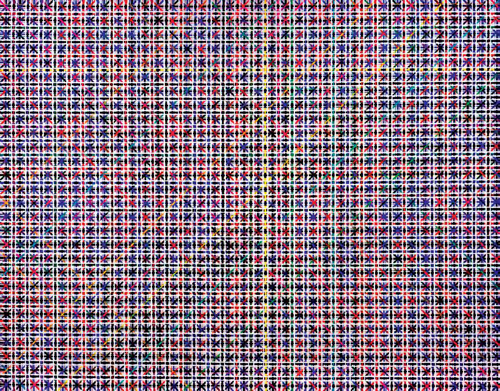
Ding Yi, Appearance of Crosses 1991-3, 1991
Art and China after 1989: Theater of the World is a large exhibition of contemporary art from China that spans the years 1989 to 2008, which can be seen as the most transformative period of modern Chinese and recent world history. The period extends from the end of the Cold War and the spread of globalization to the rise of China as a global presence, culminating in the 2008 Beijing Olympics. The exhibition highlights approximately 70 key Chinese artists and artist collectives and features nearly 150 experimental works in film and video, installation, painting, sculpture, photography, performance, and socially engaged art and activist art. The show is organized in six chronological and thematic sections occupying the second floor at the Guggenheim Museum Bilbao.
“It’s not my intention to do something that’s deliberately difficult . . . . The major challenge for me is to explore a new language with which to express myself, not to simplify the technique.” [1]
“[I] found it necessary to distance myself both from the burden of traditional Chinese culture and from the influence of early Western modernism, in order to go back to the starting point of art, in order to literally start from zero.” [2]
Born in 1962 in Shanghai, Ding Yi worked at a printing factory as a young man before graduating from the Shanghai School of Arts and Crafts in 1983. His enduring method of incorporating crosses into his work emerged in the late 1980s. While still a student in the fine arts department at Shanghai University, he began a series of painting experiments titled Appearance of Crosses, in which he used x and + shapes as a recurring motif with the intention of merging painting and design into a single form of expression.
Appearance of Crosses 1991-3 (1991) is a representative work from this early stage in Ding’s artistic development that he refers to as his “phase of technical precision.” [3] Before beginning to paint a work such as this, he would often use complex calculations in order to map out an underlying structure for the composition. In the painting process, he removed all texture from his brushwork, along with any meaning or emotion. He painted with unmixed paint, straight from the tube, and employed rulers, tape, and drafting pens to ensure the highest level of precision in his lines and colors, with the ultimate goal of achieving an effect akin to mechanical printing and industrial design.
By applying extremely rational design methods, Ding sought to “make painting that was not like painting,” [4] and for the past thirty years he has relentlessly and exclusively created abstract paintings made of small cross shapes. The majority of his work features repetitions of the plus sign superimposed in different layers, colors, and rotations; the tiny, manually painted symbols cover the entire surface of large canvases, requiring a painstaking amount of precision and technical skill. Although Ding’s methods emphasize a rational approach to painting, to some he seems perfectly attuned to the industrial development of the urban environment in a rapidly changing Communist China.
Preguntas
Show: Ding Yi, Appearance of Crosses 1991-3, 1991
If showing this work in the classroom, try to project it at its actual size. Ask students for their initial responses to the work. How do they think it might have been made?
Although Ding sees his work as a form of reflection and introspection and rejects narrative and representation in his practice, viewers have been known to layer associations onto his paintings. Depending on the colors, arrangement, and density of forms, his paintings may be evocative of rattan mats, woven fabrics, military camouflage, QR codes, mathematical symbols, or aerial views of his home city of Shanghai. Ask students if this painting reminds them of anything familiar. Create a list of associations students have with the work.
It is hard to appreciate the various ways Ding has used the x and + forms by only looking at a single work. Search Google Images for a wide range of works that Ding has created over more than three decades of using these basic symbols. Ask students to discuss how Ding’s work has changed over the years. How does seeing more of his work alter the way they think about this single painting?
Looking closely at Appearance of Crosses 1991-3, ask students to make a list of steps that Ding might have taken to create this work. Now watch “What’s Left to Appear,” a short video that shows Ding at work (http://www. timothytaylor.com/exhibitions/ding-yi-1/). How does watching the video change students’ response to his work?
